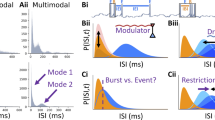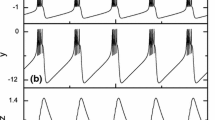Abstract
This paper examines the sensitivity of endogenous bursters to a brief input pulse. The interneurons of the lobster cardiac ganglion were selected as a case study.
Using a mathematical model specifically developed for the neurons in the cardiac ganglion of the lobster (Av-Ron et al., 1993), we show a tight link between burst characteristics and certain other parameters. We show that cells with different burst properties differ in their sensitivity to an input of a brief pulse.
Irrespective of these differences, all cells display a bimodal response to a brief pulse applied during the quiescent period. During the first three-quarters of the quiescent period, they respond by producing a single spike at most. During the remaining one-quarter, the brief pulse can initiate the cells' intrinsic burst. Our predictions fit experimental results obtained by Tazaki and Cooke (1979).
The results obtained herein are discussed with respect to fault tolerance considerations.
Similar content being viewed by others
References
Akaike N, Lee KS, Brown AM (1978) The calcium current of the Helix neuron. J. Gen. Physiol. 71:509–531.
Av-Ron E (1992) Ph.D. thesis Weizmann Institute. Rehovot, Israel.
Av-Ron E, Parnas H, Segel LA (1991) A minimal biophysical model for an excitable and oscillatory neuron. Biol. Cybern. 65:487–500.
Av-Ron E, Parnas H, Segel LA (1993) A basic biophysical model for bursting neurons. Biol. Cybern. 69:87–95.
Bertram R (1993a) A computational study of the effects of serotonin on a molluscan burster neuron. Biol. Cybern. 69:257–267.
Bertram R (1993b) Reduced-system analysis of the effects of serotonin on a molluscan burster neuron. Biol. Cybern. 70:359–368.
Friesen WO (1975a) Physiological anatomy and burst pattern in the cardiac ganglion of the spiny lobster Panulirus interuptus. J. Comp. Physiol. 101:173–189.
Friesen WO (1975b) Synaptic interaction in the cardiac ganglion of the spiny lobster Panulirus interuptus. J. Comp. Physiol. 10(1):191–205.
Hagiwara S, Takahashi K (1967) Surface density of calcium ions and calcium spikes in the Barnacle muscle fiber membrane. J. Gen. Physiol. 50:583–601.
Hartline DK (1967) Impulse identification and axon mapping of the nine neurons in the cardiac ganglion of the lobster, Homarus americanus. J. Exp. Biol. 47:327–340.
Hodgkin AL, Huxley AF (1952) A quantitative description of membrane current and its application to conduction and excitation in the nerve. J. Physiol. (London) 117:500–544.
Llinas R, Steinberg IZ, Walton K (1981) Relationship between presynaptic calcium current and postsynaptic potentiation in squid synapse. Biophys. J. 33:322–351.
Lustig C, Parnas H, Segel LA (1989) Neurotransmitter release: Development of a theory for total release based on kinetics. J. Theor. Biol. 136:151–170.
Mayeri E (1973) A relaxation oscillator description of the burst-generation mechanism in the cardiac ganglion of the lobster, Homarus americanus. J. Gen. Physiol. 62:473–488.
Parnas H, Rudolph L (1991) Representation of synapses in neuronal networks. Technical Report, The Leibniz Center for Research in Computer Science, Hebrew University, Jerusalem, Israel.
Parnas H, Segel LA (1989) Facilitation as a tool to study the entry of calcium and the mechanism of neurotransmitter release. Prog. Neur. (Kerkut GA, Phillis JW) 32:1–9.
Rinzel J (1984) Excitation dynamics: Insights from simplified membrane models. Proc. of 68th Annual Meeting of Fed. Am. Soc. Exp. Bio. St. Louis, MO.
Rinzel J (1985) Bursting oscillations in an excitable membrane model. In: RJ Jarvis, BD Sleeman, eds. Ordinary and partial differential equations. Springer-Verlag, New York. pp. 304–316.
Rinzel J (1987) A formal classification of bursting mechanisms in excitable systems. In: E Teramoto, M Yamaguti, eds. Mathematical topics in population biology, morphogenesis and neurosciences. Lecture notes in biomathematics, Vol. 71, Springer, Heidelberg, New York, pp 267–281.
Rinzel J, Lee YS (1987) Dissection of a model for neuronal parabolic bursting. J. Math. Bio. 25:653–675.
Sivan E, Segel LA, Parnas H (1995) Modulated excitability: A new way to obtain bursting neurons. Biol. Cybern. 72:455–461.
Tazaki K, Cooke IM (1979) Spontaneous electrical activity and interaction of large and small cells in cardiac ganglion of the crab Portunus sanguinolentus. J. Neurophysiol. 42:975–999.
Author information
Authors and Affiliations
Rights and permissions
About this article
Cite this article
Sivan, E., Parnas, H. & Dolev, D. Relationship between burst properties and sensitivity to input: A theoretical analysis. J Comput Neurosci 3, 35–50 (1996). https://doi.org/10.1007/BF00158336
Received:
Revised:
Accepted:
Issue Date:
DOI: https://doi.org/10.1007/BF00158336




